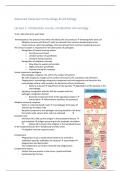Class notes
Summary of lectures Advanced molecular immunology and cell biology (AM_470656)
- Course
- Institution
Summary and notes of the lectures of the course Advanced molecular immunology and cell biology. Important supporting images of lectures are included in the summary.
[Show more]



